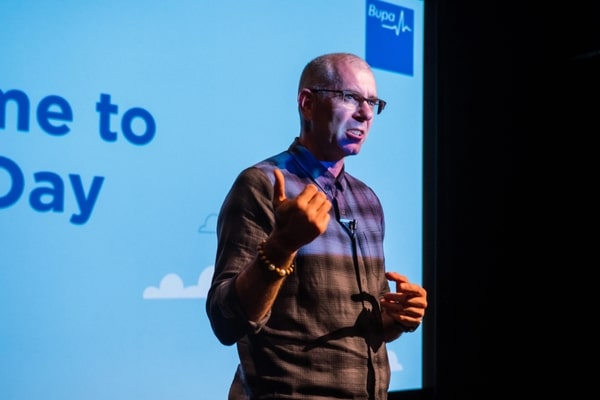3 min read
Welcome to the second in Spixii's Spotlight Series, designed to interview influencers in the InsurTech space. This month, we talk to John Moore about the story behind Bupa's Customer Lab.
Hi John! Why did you decide to set up the Customer Lab?
The Customer Lab took about a year working on different parts of the business, taking advice from consultants, talking to startups and looking at other businesses until deciding this is what we wanted to do: a customer-focused change for the company. We knew we couldn't do that alone so we had to build a community of startups and partners.
Regarding innovation and change, you can't just say 'I'm going to innovate'. You really must change the way you work, and strive to bring the principles of human-centred design to solve problems. It's about having a safe place in the organisation to see what works and what doesn't.
 John Moore, Bupa Customer Lab
John Moore, Bupa Customer Lab
Where do you see the future of customer interaction and engagement with insurers?
I think the future of insurance companies lies in engagement. Whether we like it or not, whatever insurance you look at, the most common is grudge purchase across the board. The reason people take out health insurance is for peace of mind if they become unwell. What they ideally want is to become healthier. Financial support is a big factor, but we're interested in helping them get more. Human touch and technology will both play a part in this.
Technology allows us to scale support through devices our customers want to interact with us on, which for now is mainly mobile. But there will always be a desire to see or interact with a person. Technology handles triage capability; when people want answers instantly, technology can help with that and steer them in the right direction.
It's also important to provide choices. Some people might be tech-savvy or have questions that are easy for technology to answer. Others might decide actually, 'No, I want more information'. We must understand the nuances between the two.
Would you agree the way forward for insurance companies is to innovate and partner with insurtech startups?
I don't think any company today will have the breadth of focus or the availability of space within their talent and organisation to do everything possible. So much of what the company's doing is the day-to-day delivery to help customers. The best way to innovate is to bring the external in: integrate the startup community within the core company. Startups focus on a specific piece of the puzzle. This combination is the way forward, and was the focal point of starting the Customer Lab.
What's more, when finding a name for the programme, realistically 'Customer Lab' made sense. After all, it improves the experience of an employee, customer or provider. Yet actually, everything we do is rooted in the core customer service. Technology can help provide a better service for this.
From your experience of the Blue Table programme and Demo Day, what advice would you give to other companies looking to create an internal innovative culture?
First, don't separate from your core business. During the Blue Table programme, we had five companies sitting in our business, connected with a real customer problem and working on providing a solution. We expected these businesses to work day-to-day with ours.
Time-boxing is also a really powerful tool to force things you wouldn't normally have. Things you thought wouldn't be possible can be. Our decision to force time-boxing was integral to the outcomes we could achieve in the time period of 10 weeks.
Finally, really engage your business sponsors even right through to the demo day. Make sure they see the outcome is as important as the beginning.
What three things make a successful partnership between insurers and startups?
Firstly, that there is an alignment around the same customer problem, and that the solution financially stacks up. Secondly, that there is willingness within the organisation to adapt to the startup's way of working. And thirdly, that the startup is also willing to learn and adapt to the requirements within a larger corporation, such as its legal and regulation departments. When your brand is known, you cannot afford to take risks.
Ultimately, it's about managing all the nuances as a partner, rather than a provider. We as an organisation need to adapt. We want to learn from startups on how to find solutions. It's a win-win for both.

Do you see a place for chatbots in marketing insurance? What's your ideal chatbot use-case?
The reality is whether we like it or not, insurance products (in all forms) are very complicated. No matter how good a communicator you are, to explain and get people comfortable with the thought they're getting what they thought they're getting is a challenge. It means speaking in their own language.
In a perfect world, we'll have people on the other end answering all those potential questions from customers. However, a chatbot holds a massive opportunity to deliver great customer service, giving our customers confidence that they know what they're buying.
Look at how insurance used to be sold: we went from a face-to-face conversation buying insurance to buying on a website. What people want now is a combination of the two: the ability to have a face-to-face conversation in a digital environment.
The key to adding the human touch to scaling technology? Be open and honest with the customer, so they realise they're not talking to a human but a digital solution. We don't want to kid customers this chatbot is human, but having the ability to ask questions is extremely powerful.
Take travel insurance for instance. Everyone goes on holiday once in a while, some people cycle and others don't. A chatbot could allow you to ask straight away, "Does this cover me on a bike?" Not many people would read a document but a chatbot allows those questions to be answered, quickly and efficiently.
I believe the chatbot helps you through a process from A to B, pre-empting some of the things people may have doubts on, giving guidance and steering. What I want from the end of an online purchase is confidence I've made the right decision and asked all the right questions, including the ones I didn't think to ask. You're buying insurance to be protected from things you don't want to happen, so you're not always the best at imagining what might happen. If you've never lost luggage before, you might not ask that question!
Chatbots will not only be able to answer questions you have. They can also use history collected over time to ask questions you didn't think of. In insurance, that's really important; in most cases, we're insuring against things that haven't happened to us before.
